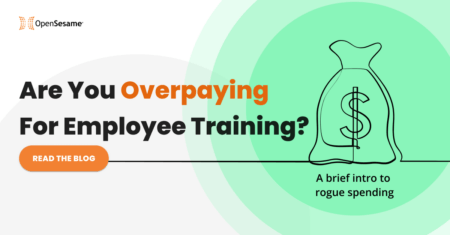Curb rogue spending around your L&D program, while achieving organizational alignment and addressing your team’s needs.
For many leaders and training professionals, building and launching a successful learning and development strategy is an arduous journey, filled with essential elements and components that demand consideration during the purchasing and planning process. Will my learners engage in the content? Will my program solve the challenges my team is facing? Will I see a return on my investment? There are many ways you can measure the effectiveness of your program, but how do you know if you’re overpaying for it? To help answer that question, let’s examine the biggest antagonist to ROI and a damaging, but sometimes, silent adversary to L&D success: rogue spending, and what areas are affected by it and steps that can be taken to avoid or fix it.
What is rogue spending? And how does it happen?
Rogue spending, also referred to as “maverick or tail end spending,” refers to the unexpected and unpredictable spending that can happen outside of negotiated contracts. With learning and development having such a direct correlation and impact on business success, and with elearning becoming an essential method to drive L&D programs, there are many ways you or your company can easily become rogue spenders. The popularity of elearning reached an all-time high this past year, increasing the accessibility to elearning content while presenting many opportunities to find the right provider and many opportunities to become a rogue spender. One of the main reasons L&D professionals fall into this trap is the lack of time they have to research the value of what some publishers are providing, and how the materials will meet the needs of their team. In many cases, leaders are stuck in the present, focused on immediate needs and trying to find a quick remedy, rather than searching for a solution that can be used to meet both the current and future needs of the organization.
Perhaps the most common reason for rogue spending is lack of communication and coordination between teams. With HR, I.T., and other essential departments scrambling and searching through the many choices to find training that they believe are specifically related to their different focus areas, it’s easy for a company to purchase multiple learning solutions, including different LMS’, to cover them. The training areas that are typically the root of this problem are usually ones that are used across multiple departments and are intended for a broader audience like business skill development or leadership training.
The consequences of rogue spending
Companies taking the time and effort to invest in training their greatest asset (their workforce) should be cause for celebration, but no matter how positive the intention might be, taking an unfocused approach could have damaging effects with immediate impact to the learning and development budget. When departments spend various amounts on different providers and systems, it’s difficult to measure the quality of each training. And if the training is in a broad topical area, like sexual harassment prevention, for example, the organization may end up becoming misaligned due to the differences in what is being taught, and how it is being taught. This could not only increase the likelihood that an organization’s compliance would be at risk, but will almost certainly have a direct, negative impact on the learners themselves, restricting both their growth and the growth of the organization.
Three steps to prevent rogue spending
So how can you prevent rogue spending? The experts at McKinsey cite one comprehensive way of solving this problem by recommending that L&D leaders take on a broader role within their organization and establish their vision around a holistic, coordinated L&D strategy that engages the organization and encourages collaboration. But in order to solve the problem, you have to first know where the problem is occurring in the first place. Conduct an audit and uncover what training programs each department is using and for what purposes. If there are similarities in the topical areas, you can choose one based on cost-value or user feedback.
Speaking of feedback, perhaps the most effective tool is having regular, informative communication between your teams and stakeholders. Building awareness and understanding around each team’s needs, both present and in the future, can help create a strategic approach behind the learning and development program.
With this knowledge, you can work with your procurement team and leaders to evaluate training technology and content and see if what you currently have matches everyone’s needs. After following these steps, you’ll be positioned to formulate a learning and development strategy that will drive meaningful conversations, build engagement, keep everyone safe and compliant, and above all, keep your budget spending manageable.
What’s next?
So what steps can you immediately take to get started? OpenSesame’s learning experts are ready to do the work for you by providing a no-cost assessment. Our team speaks with learning managers from different departments on a daily basis, partnering with them to identify where duplicate purchasing is happening, while sharing our customer’s best practices on where our all-encompassing, singular catalog of elearning content can help.
OpenSesame is ready to do all of the coordinating for you, bringing in all relevant stakeholders, including your procurement team, to evaluate your needs and provide you with a strategic solution that is designed for employees in specific roles, departments, locations, and industries. Above all, OpenSesame works to make sure that our customers are maximizing their budget, mitigating rogue spending, and obtaining ROI by getting everything they need from one source.






